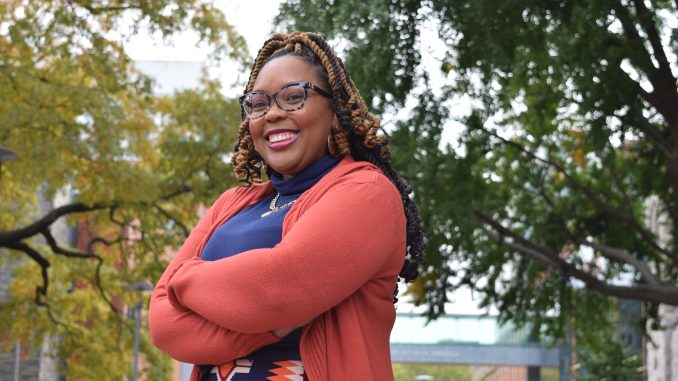
Tiffany Montgomery became fascinated with childbirth at an early age, but never saw it as a potential career path that could lead her to be the first Black associate editor at a scholarly publication.
On Sept. 1, Montgomery became an inaugural associate editor of the journal Nursing for Women’s Health, a publication within the Association of Women’s Health, Obstetric and Neonatal Nurses, which focuses on evidence-based practices for women’s health, childbearing and neonatal care. After being a member of AWHONN since 2007, this promotion makes her the first Black editor of any AWHONN scholarly publication.
“It is an indication to me that things are changing in nursing,” said Montgomery, an assistant nursing professor. “Change is sometimes a slow process, but the wheels are spinning, people are finally realizing that there needs to be more diversity.”
As an associate editor, Montgomery is working to incorporate more inclusive language to bridge the gap between community and research and ensure there’s diversity, equity and inclusion in everything the publication does. She is creating new author guidelines at the journal that appropriately label individuals and communities, using words like “minoritized” instead of “minorities,”and “research participants,” instead of “study subjects,” Montgomery said.
Unable to afford a college education, Montgomery enrolled in a phlebotomy training course, learning how to draw blood, her senior year of high school and became a licensed phlebotomist before graduating, hoping her certificate would get her foot in the door and help pay her way through college, she said.
Montgomery enrolled at San José State University in California in 2000 to obtain her bachelor’s degree in nursing and went on to receive a master’s in nursing and nursing education from California State University, Dominguez Hills in 2010. She graduated from the University of Pennsylvania in 2019 with a master of science in health policy research.
After graduating from Penn, Montgomery worked with a community-based participatory research fellowship in West Philadelphia for two years. Once the fellowship ended, she applied to teach at multiple universities, but chose Temple because she felt it was the best option, she said.
Montgomery did not have any Black professors while working toward her master’s and Ph.D. degrees and used that as motivation to pursue nursing education, she said.
“I wanted people to see that we’re here, we exist, Black nurses, we do exist,” Montgomery added.
While at Temple, Montgomery strives to build relationships with and encourage students she teaches to pursue medicine.
“That is really my purpose in this position — to kick up dust, and to make changes and to make a way for other scholars to be recognized for their work, scholars who traditionally are not recognized,” she added.
In 2019, non-Hispanic, Black nurses represented only 7.8 percent of nurses, according to the United States Census Bureau.
There is a lack of representation and diversity in the publishing industry as well.
In 2019, 76 percent of all employees in the publishing industry were white or Caucasian, while all other ethnic groups represented 7 percent or less of all employees, according to a 2019 Statista report on the U.S. diversity levels in the publishing industry.
Kimmika Williams-Witherspoon, an associate professor of urban theatre and community engagement and Montgomery’s colleague, feels representation in the classroom and working fields are vital, she said.
“When you have a role model, someone that you can look to, then it inspires the next generation of learners, educators and even practitioners because they see that, if you could do it, I could do it,” Williams-Witherspoon said. “This opens up an additional lens for looking at what dreams could be accomplished.”
While AWHONN attempts to be more diverse and inclusive in the content they produce, there is always room for improvement, said Jonathan Webb, chief executive officer at AWHONN.
Webb is grateful to have her working within AWHONN and looks forward to seeing what she will bring to the table in the coming months, he said.
“It’s a fantastic opportunity to be able to have leaders like Dr. Montgomery be in positions of influence, to make sure that her experiences and experiences of those people like her and the patients that she served are first and foremost within the work that we do,” Webb said.
Montgomery hopes to highlight sexual and reproductive health disparities among vulnerable populations and increase diversity within the nursing profession in more ways than just racial and ethnic diversity, she said.
“That’s also age diversity, gender diversity, diversity of religion or faith practices, regional diversity,” Montgomery said. “I mean, diversity doesn’t just hinge on what we look like, and that’s one of the things that I want to bring to light. My purpose in nursing at this point is to do that.”
Correction: A previous version of this story misquoted Tiffany Montgomery’s thoughts one of the ways nursing should diversify besides racial and ethnic diversity
Correction: Tiffany Montgomery only applied to one school in Philadelphia.



Be the first to comment